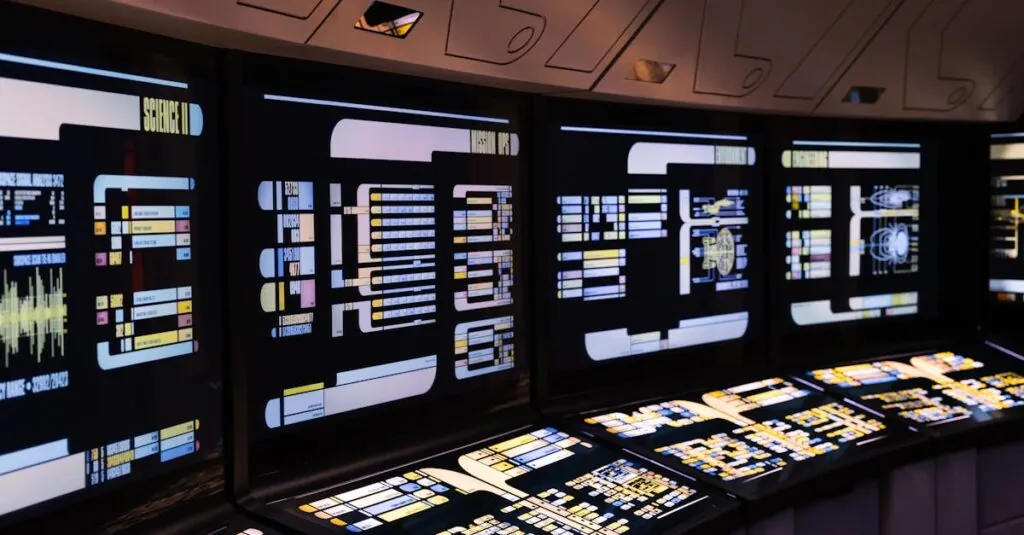In a world where robots might soon take over our coffee-making duties, autonomous systems design is the unsung hero behind this technological revolution. Imagine a future where machines think for themselves, navigate traffic like seasoned pros, and even help you find your missing left sock. Sounds dreamy, right? But before we start dreaming of our robot overlords, it’s essential to understand the art and science of designing these intelligent systems.
Table of Contents
ToggleOverview of Autonomous Systems Design
Autonomous systems design encompasses the principles and methodologies that guide the creation of machines capable of performing tasks independently. Understanding this domain is essential for developing intelligent machines that enhance daily activities.
Definition and Scope
Autonomous systems refer to technology designed to operate without human intervention. This encompasses various applications, from autonomous vehicles to robotic assistants. The scope includes the integration of hardware and software that enables decision-making in real-time environments. Specific areas, such as robotics, artificial intelligence, and machine learning, contribute significantly to autonomous systems design. Rapid advancements in these areas expand the capabilities of autonomous systems, making them increasingly present in diverse sectors like healthcare, transportation, and agriculture.
Key Components
Key components of autonomous systems include sensors, algorithms, and actuators. Sensors gather data from the environment, providing critical information for decision-making. Algorithms analyze this data, allowing systems to interpret the surroundings and determine actions. Actuators execute these actions based on algorithmic outputs, effectively implementing the decisions made. A seamless integration of these components ensures efficient operation of autonomous systems. Redundancy enhances reliability, enabling systems to function safely and effectively in unpredictable circumstances. Robust communication channels are also vital, allowing for real-time data exchange between various system components.
Design Principles of Autonomous Systems
Autonomous systems design incorporates fundamental principles that ensure effective and reliable performance. Focus on key concepts like modularity, scalability, safety, and reliability plays an essential role in shaping intelligent machines.
Modularity and Scalability
Modularity allows designers to create independent components that facilitate flexibility in system upgrades. Each module can function separately while contributing to the overall performance of the system. Scalability enables the system to adapt to varying tasks and increased demands without significant rework. Systems designed with scalability in mind allow for easy integration of new technologies, ensuring longevity and relevance. Autonomous vehicles and robotic assistants showcase how modular designs support diverse applications while simplifying maintenance.
Safety and Reliability
Safety constitutes a non-negotiable principle in autonomous systems design. Developers must embed rigorous safety protocols to minimize risks associated with system failure. Reliability ensures consistent performance in diverse operating conditions. Established practices, such as fail-safe mechanisms and real-time monitoring systems, enhance trust in autonomous operations. Creating robust communication channels between components eliminates potential failure points and promotes operational integrity. Implementing these principles leads to successful applications across vital sectors, including transportation, healthcare, and industrial automation.
Technologies Used in Autonomous Systems Design
Autonomous systems design relies on numerous advanced technologies that drive intelligent functionalities. Two critical components include artificial intelligence and sensor integration.
Artificial Intelligence
Artificial intelligence serves as the brain of autonomous systems, enabling them to learn and adapt. Machine learning algorithms allow systems to process vast amounts of data, improving decision-making over time. Deep learning techniques further enhance capabilities, facilitating image and speech recognition. Models train on historical data to predict future outcomes or recognize patterns. Solutions such as reinforcement learning empower systems to optimize their actions based on feedback. AI’s integration in autonomous vehicles leads to improved navigation and safety features, while robotic assistants benefit from enhanced interaction with users.
Sensor Integration
Sensor integration plays a vital role in gathering real-time environmental data. Various types of sensors, including cameras, LIDAR, and radar, collect critical information about surroundings. Data fusion techniques combine inputs from multiple sensors, providing accurate situational awareness. High-precision GPS can improve localization in autonomous navigation. Sensors detect obstacles, identify landmarks, and monitor conditions, ensuring system responsiveness. Additionally, feedback loops enable systems to adjust actions based on sensor data, contributing to safety and efficiency. Robust sensor integration allows autonomous systems to operate effectively across diverse applications, such as agriculture, healthcare, and manufacturing.
Applications of Autonomous Systems
Autonomous systems play a vital role in various sectors. They streamline operations and enhance efficiency across multiple industries.
Transportation
Autonomous vehicles transform the transportation landscape. They reduce human error, a leading cause of accidents, by utilizing advanced sensors and algorithms. In urban settings, these vehicles optimize traffic flow, minimizing congestion and emissions through smart navigation. Ride-sharing platforms also adopt autonomous technology, increasing convenience for commuters while lowering travel costs. Moreover, public transportation benefits from autonomous systems, offering reliable services that can adapt to fluctuating demand.
Healthcare
The healthcare sector greatly benefits from autonomous systems. Robotic surgical assistants enhance precision during procedures, improving patient outcomes. Autonomous delivery drones distribute medical supplies quickly, particularly in remote areas, ensuring timely access to critical resources. Monitoring devices track patient vitals in real time, allowing for immediate intervention when necessary. Additionally, telemedicine platforms utilize autonomous features to connect patients with healthcare providers efficiently, expanding access to medical care for underserved populations.
Challenges in Autonomous Systems Design
Autonomous systems design faces multiple challenges impacting development and deployment across various sectors. Understanding these challenges provides insight into the complexity of creating intelligent machines.
Ethical Considerations
Ethical dilemmas persist in autonomous systems design. Designers must tackle issues related to decision-making processes and accountability. For instance, how an autonomous vehicle prioritizes passenger safety over pedestrians raises significant moral questions. Privacy concerns also emerge, especially regarding data collection and surveillance capabilities. Developers need to consider the implications of AI bias that could influence algorithmic decisions. Societal acceptance hinges on transparency in how these systems function and make decisions.
Technical Limitations
Technical constraints pose significant hurdles in autonomous systems design. Robustness and reliability are essential for system performance under various conditions. Environmental variability can challenge sensor accuracy, affecting decision-making capabilities. Complex algorithms require substantial computational resources, sometimes leading to latency issues. Scalability also emerges as a concern, particularly when adapting systems to new tasks or environments. Testing and validation processes become critical, needing comprehensive simulations to ensure safety in real-world applications.
The evolution of autonomous systems design marks a significant leap in technology. As machines gain the ability to operate independently, they open doors to unprecedented efficiencies and capabilities across various sectors. The careful integration of hardware and software underpins their functionality, ensuring real-time decision-making and adaptability.
Addressing ethical and technical challenges remains essential for fostering public trust and acceptance. By prioritizing safety, reliability, and transparency, developers can create systems that not only enhance productivity but also align with societal values. The future of autonomous systems is bright, promising innovations that will transform how people interact with technology in daily life.










